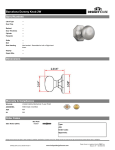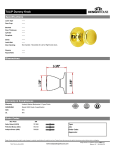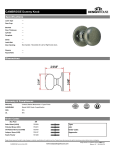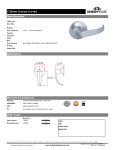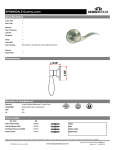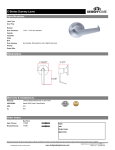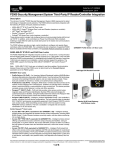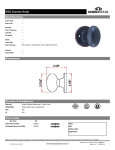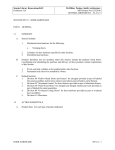Download Installation Guide for AO19 Control Module / B1000S
Transcript
INSTALLATION GUIDE FOR AO19 LOW ENERGY AUTOMATIC DOOR OPERATOR CONTROL MODULE B1000S – SUPER SWING User Manual Date: July 3, 2008 Note: This product is a low energy automatic door operator and must be installed / serviced by a qualified person . The service technician must be familiar with the latest ANSI /BHMA A156.10/19 standards . NEVER sacrifice the safe operation of the automatic door for an incomplete solution. Call the factory for technical support . P/N 103188 1 AO19 Low Energy Automatic Door Operator Module Description / Connector Pinouts ISP / Synchronization Connector J 1 ISP – (In System Programmer ) FACTORY USE ONLY Synchronization – This connector is used to synchronize two modules together (For Dual door operator ). Synchronization cable , part number 104785. When the synchronization cable is used , the activation switch (es) can be wired to only one module . All signals , except for the “Delayed Activation” , are shared between the two modules via the synchronization cable. When the “Delayed Activation Timer” expires , an activation signal is sent to mate control. Note: Using the synchronization cable will not synchronize the door speeds are kept separately . . The speeds 2 Signal and Sensor Power Connector – P2 High - Low Low Energy High Energy use and must conform to ANSI/BHMA A156.10 Low Energy ANSI/ BHMA A156 .19 Pin Signal Definition J2.1 Logic ground J2.2 Activation 1 J2.3 Activation 2 J2.4 Safety A J2.5 Safety B When the door is fully closed , this signal to ground will prevent an activation. During the opening cycle , the door will go to safety speed when this signal is to ground. When the door is fully opened, this signal to ground will prevent the door from entering the closing cycle . J2.6 Delayed Activation This signal to ground will start the delayed activation timer . When the timer expires, an activation is generated. This signal is used to do door sequencing. J2.7 Hold Open This signal to ground will hold the door opened. If the module is in the ON mode, (Low voltage ON/OFF must be to ground) and no current fault is present. J2.8 Low Voltage ON/OFF This signal to ground enables the module. This module is disabled if this signal is not to ground. J2.9 Data + This is a signal output for sensor which requires door status information. When door is closed, Data output is 0V When door is in the opening cycle, Data output is 12V When door is closing (in motion), Data output is 8V J2.10 Logic ground/Data - Ground reference for signals and power J2.11 (+24VDC) DC power to sensors J2.12 J2.13 (24VAC) (24VAC) AC power for sensor J2.14 Electric lock switch (Common) J2.15 Electric lock switch (normally open) J2.16 Electric lock switch (normally close) Ground reference for signals and power. This signal to ground will activate the operator. If the module is in the ON mode (Low voltage ON/OFF must be to ground) and no current fault is present. Note: Manual use of the door will not enable this input. This signal is active when the door is in motion . IF the module is in the ON mode (Low voltage ON/OFF must be to ground) and no current fault is present. Note: Manual use of the door will not enable this mode. When the door is fully closed , this signal to ground will prevent an activation. During the opening cycle (with lockout option to OFF), the door will go to safety speed when this signal is to ground. During the closing cycle (with lockout position to OFF ), the door will go to a very slow speed when this signal is to ground. When the door is fully opened, this signal to ground will prevent the door from entering the closing cycle. (300mA max.) This connection is the common to drive an electric lock . (Active when electric lock option is set to ON) This connection is the normally open (NO) to drive an electric lock (Active when electric lock option is set to ON ) This connection is the normally closed (NC) to drive an electric lock (Active when electric lock option is set to ON ) Power Source (120VAC input connector ) – J3 Pin Signal Definition J3.1 AC Line - BLK J3.2 AC Neutral - WHT J3.3 AC Ground - GRN Power required is 120 VAC 50/60 Hz (Maximum current is 3Amperes 3 Refer to ANSI/BHMA A156.10 / 19 4 5 Refer to ANSI /BHMA A156.10 / 19 for more information 6 Refer to ANSI /BHMA A156.10 / 19 for more information 7 Point to Point Dwg for AO19 Low Energy Automatic Door Operator Refer to ANSI/BHMA A156.10 / 19 for more information, or Call factory at 1-800-729-3839 24VAC Strike (if used) 8 Dual Door Operator Sync Cable P /N 104785 For dual door operator , plug Sync Cable P/N 104785 as shown below. When using the Sync cable, only one control maybe wired to the switches . All signals are shared between the two controls using the sync cable, except for the “Delayed Activation” input. When the “Delayed Activation Timer” expires, an activation signal is sent to the mate control Sensor power can be supplied by both controls for a total of 600mA. Master Controller In dual/twin mode, set the “Activation timer” and “Push & Go timer” trimmers to the value needed . Note: Slave Controller The Sync cable, P/N 104785 , has two wires switched at one end of the cable . Important : In dual/twin mode, set the “Activation timer” and “Push & Go timer” trimmers to the maximum value (Fully clockwise) for the slave controller . Electric lock for twin doors For one controller to control the electric lock (s), wire the electric lock(s) to one controller. Set the option #3 to “ON” for that controller only . Wire the activation signal(s) to the controller that is wired to the electric lock. For two controllers to control the electric locks (to keep the electric locks independent), wire the first lock to the first controller , the second electric lock to the second controller . Set the option # 3 to “ON” on both controllers. Wire J2 pin 2 (Activation 1) of the first controller to J 2 pin 2 (Activation 1) of the second controller. 9










